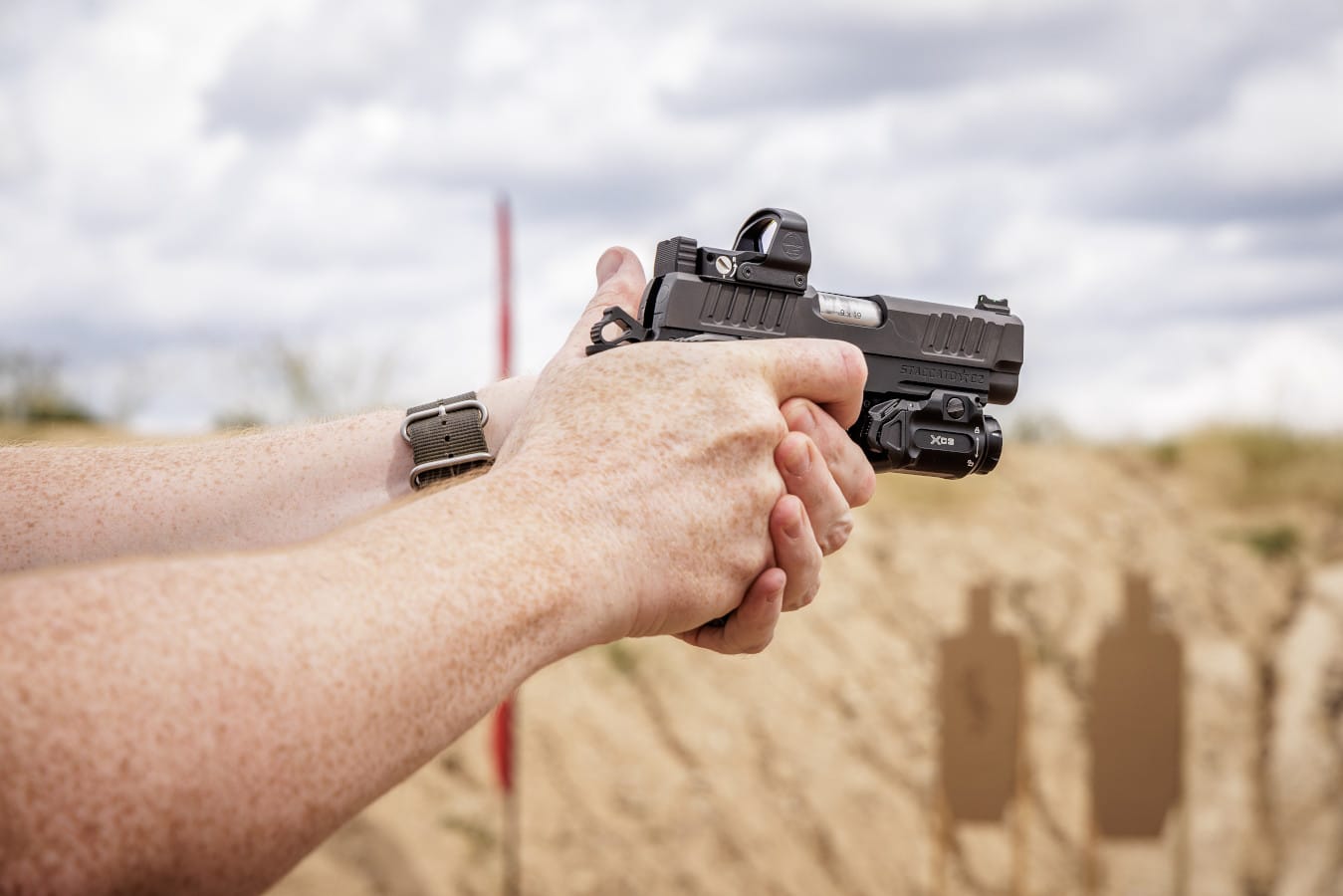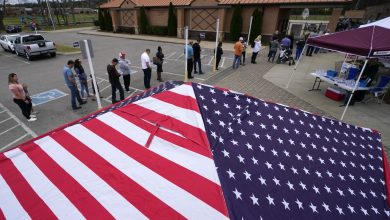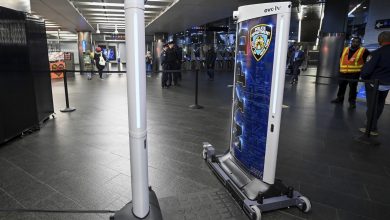When it comes to weapon-mounted duty lights for law enforcement and military professionals, the SureFire X300U is considered by many to be the gold standard. However, SureFire’s forays into the compact weaponlight segment haven’t always been as successful. Back in 2015, the company launched the XC1, a AAA-powered light with 200 lumens and a 1.5-hour runtime.
Over the next few years, they revised this series with an optional laser and improved 300-lumen output. More recently, there was the XR1, which offered 800 lumens with dual LEDs powered by a rechargeable battery. But each of these designs required proprietary holster fitment and relied on atypical batteries, so they didn’t achieve the same level of widespread adoption as the full-size X300 series.
- Lumens: 550
- Candela: 7,200
- Max. Runtime: 1.75 hours
- Battery Type: CR123A
- Rail Compatibility: Universal handgun or Picatinny rail (adapter included)
- Switch Type: Ambidextrous, momentary or constant-on
- MSRP: TBD
These days, if you’re looking for a compact weaponlight, most people will recommend Streamlight’s TLR-7. SureFire aims to change that with the release of its all-new XC3, which it calls “the new standard in duty-grade compact weaponlights.”
Unlike previous models, the XC3 uses a front-loaded CR123A battery and fits into a variety of existing holsters (the same ones designed for the aforementioned TLR-7). Output is a healthy 550 lumens and 7,200 candela, making it far more usable at intermediate ranges than the wide, unfocused beam of the old XC1. It’s described as a Hybrid beam pattern, with a strong central hotspot as well as wide spill to illuminate the target’s surroundings.
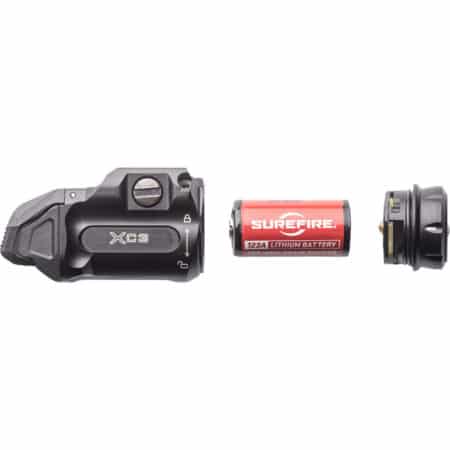
We’re also pleased to see that SureFire went back to the drawing board for its ambidextrous switches, which now have a tactile click for constant-on or can be held down for momentary use. The pivot point for the switch is high on the light’s anodized aluminum housing, allowing easy activation with the shooter’s thumb or index finger.
In order to prevent inadvertent activation while the gun is packed in a bag or case, the light’s bezel can be loosened to a lockout detent position, temporarily disabling the switches.
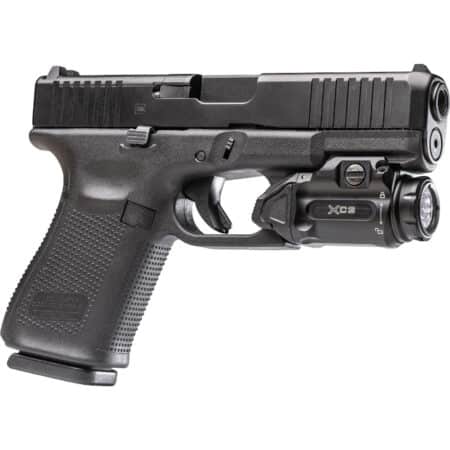
As with all SureFire illumination products, the XC3 is made in the USA. Final pricing is still to be determined, but we’re told MSRP will be under $350.
A few months ago, SureFire invited us out to Texas for a sneak peek at the XC3. The event — dubbed the SureFire Texas Showdown — took place at the Staccato Ranch in Florence, TX, and allowed a handful of media members to test XC3 prototypes on the range. SureFire also brought out Matt Pranka, a former Delta Force operator, current USPSA Grandmaster, and founder of the firearms training company Xray Alpha LLC. Over the course of three days, Pranka ran us through drills that ranged from pistol fundamentals through weaponlight implementation, target transitions, and movement.
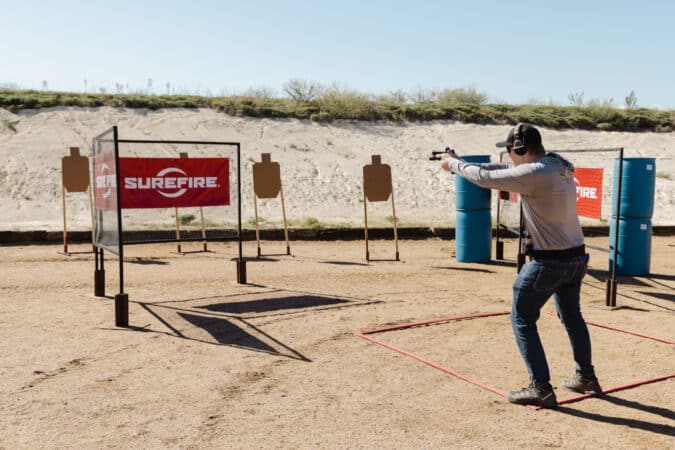
Rather than just watch a Powerpoint presentation about the new light, we actually learned how to use it effectively through challenging drills. As a SureFire rep explained, “Having the right tool is half of the equation, the other is proper training.”
Each attendee was provided with a Vertx 50-liter duffle bag full of range gear for the course. This included a Safariland competition belt and mag pouches, a QVO Tactical Kydex OWB holster, a Tenicor IWB holster and inner belt, Oakley SI shooting glasses, and reduced-scale dry fire targets from Ben Stoeger Pro Shop.
Since we were at Staccato Ranch, former Recoil staff member Tom Marshall got us set up with loaner Staccato 2011 pistols, each equipped with a red dot and a SureFire XC3 light. Staccato also provided 136gr OTM 9mm match ammo, which made our already smooth-shooting C and C2 pistols even smoother.
Training began during the daylight hours in order to familiarize each shooter with the XC3-equipped Staccato pistols. Unlike many instructors, Pranka didn’t want us to show proficiency by stacking rounds on top of one another at 5 yards.
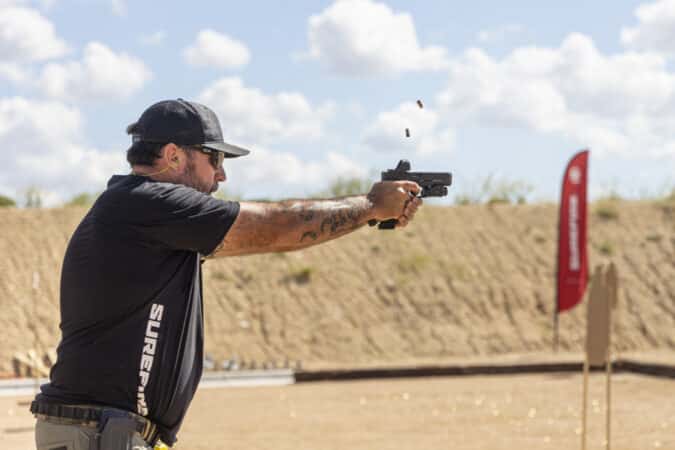
He explained that an extremely tight group indicates you’re not stressing yourself to the point of making mistakes, which means you’re probably not learning anything. Instead, he recommended working on keeping about 90 percent of shots inside the A zone — that’s an indicator that you’re pushing yourself a little, but not so much that you’ve lost control. Regarding distance, Pranka believes that true training happens at 12 yards or more, so many of our drills took place between the 15 and 25 yard lines.
As for speed, we were told to train fast as a baseline, since most defensive shootings happen faster than the pace of typical range training. Pranka recommends a warmup at 70 percent of maximum speed, practice between 80 and 90 percent, and gradually pushing the limit up to 100 percent until the wheels fall off. Once that happens, back off to normal practice speed and repeat. “I always want to be ready to shoot sooner so I don’t have to shoot faster,” Pranka said.
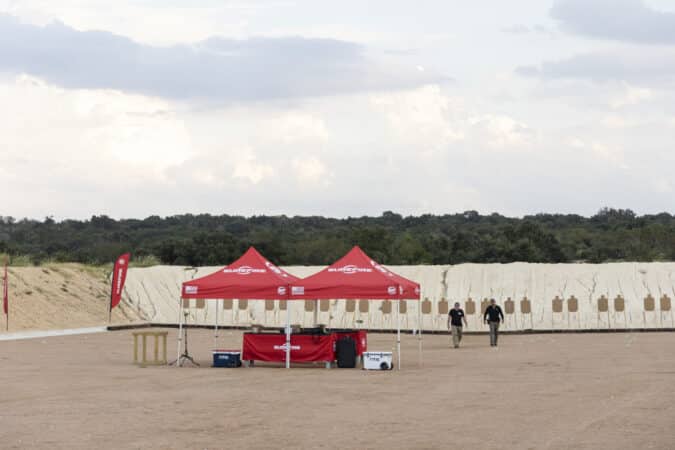
Each shooter was reminded of the importance of a solid support hand grip in order to maintain stability. Pranka uses liquid chalk — the same type rock climbers apply — to keep his grip locked in and eliminate the effects of sweaty hands. While this is common in competitive shooting circles, Pranka says he also used it during his military career, applying a little as part of his pre-mission prep routine.
A heavy emphasis was placed on the visual aspect of shooting with a red dot — namely remaining target-focused rather than chasing the dot with your eyes. Pranka said, “When I’m target-focused I feel like I’m not aiming enough, and that my mistakes are worse than they really are.” He also reminded us of an analogy used by his friend Ben Stoeger: the red dot is like the beautiful woman who walks through the restaurant while you’re eating dinner with your wife. It’s OK to be aware of her presence, but if your eyes lock onto her, you’re going to get into trouble.
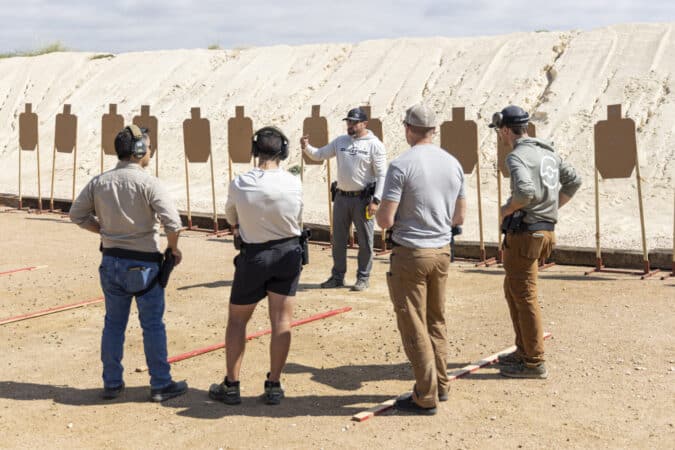
As another rule of thumb, if your red dot looks like a crisp red dot, you’re probably focused on it too much. “Most of the time my dot looks like a slash or a blur of bright color, not a dot,” Pranka explained. Given this statement, Pranka bases all shooting on three “levels of confirmation”:
- Target visible through optic housing — This is essentially an emergency sight picture that can be used as a last resort.
- Flash of color — While focusing on the target, you become aware of the bright red color of the dot crossing into your line of sight. This is used in most situations.
- Dot looks like a dot — For especially challenging shots, you may want more precise awareness of the dot, so a higher confirmation level is necessary. However, still avoid focusing on the dot!
To practice “color confirmation,” we fired six rounds each at 5, 10, 15, and 20 yards. While our vision never switched away from target focus, we slowed down our splits between shots as distance increased. Resisting the urge to chase the red dot produced measurable improvement for each shooter.
According to Pranka, who relied on low-light shooting skills extensively during his special operations career, shooting at night is actually easier in some regards. There’s less visual noise in your peripheral area, and your eyes are naturally drawn to the target that’s lit up by your weaponlight. The biggest challenge is to become proficient with activating the light in the desired mode while drawing and manipulating the gun, which Pranka calls “switchology.”
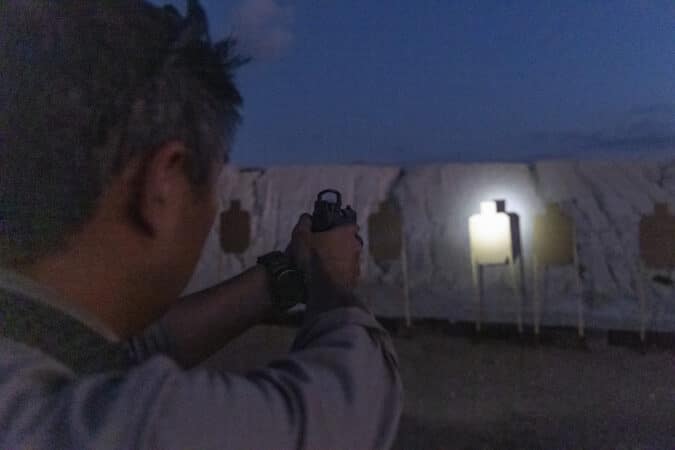
Since a Staccato 2011 has a manual safety that must be deactivated on the way up to the target, activating a weaponlight at the same time offers some dexterity challenges. While some shooters preferred to activate the light with their index finger before moving to the trigger, most found it more natural to sweep both thumbs down along the side of the gun while building their grip. This way, the dominant thumb clicks off the safety, and the support thumb clicks on the light.
At this point, we experienced a hiccup with our prototype XC3s. After hundreds of draws from our tight new Kydex holsters, many of the 3D-printed prototype switches had dragged on the inside of the holsters enough to become dislodged and damaged. These things happen sometimes with pre-production products.
Thankfully, SureFire immediately made its engineering team aware of the issue, and the switches and backplate on the production version of the XC3 are now made of much more rigid glass-filled polymer to prevent it from happening in the future.
Although we weren’t able to spend as much time illuminating targets with the XC3 as we’d hoped due to the aforementioned issue, we saw enough for a good first impression. The beam pattern is much more comparable to a full-size X300U than we anticipated given the XC3’s size. It’s certainly a drastic improvement over SureFire’s previous compact weaponlight offerings.
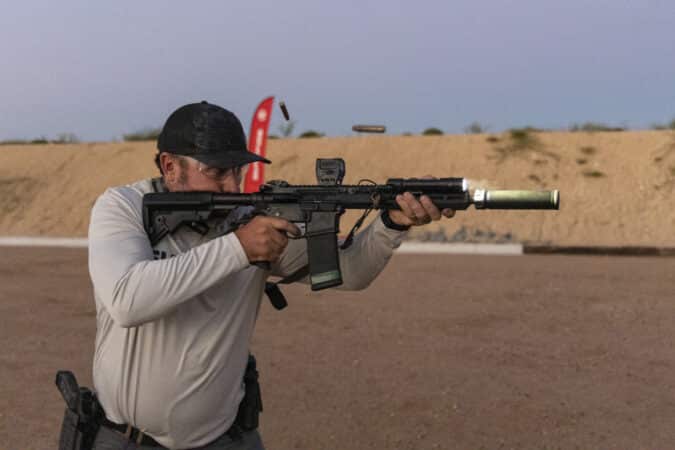
Compared to the Streamlight TLR-7 — a light that currently resides on this author’s carry pistol — the XC3 offers slightly more lumens with substantially higher candela (44 percent more than the TLR-7’s 5,000 rating). The Streamlight also produces cool white light, whereas the SureFire appeared noticeably warmer.
Streamlight recently released an HL-X variant of the TLR-7, which offers 500 lumens and 11,000 candela with a CR123A battery, but it does so at the expense of a longer light bezel that prevents it from fitting most standard TLR-7 holsters. The intense hotspot of the SureFire XC3 allows it to perform more like a full-size weaponlight without sacrificing its compact dimensions, and we’re confident it’s going to give Streamlight a real run for its money in this segment.
After three days on the range and a variety of drills, the SureFire Texas Showdown culminated with a competition stage. To up the ante, each shooter ran the stage first thing in the morning with no warm-up and was scored based on hit factor. While none of us performed flawlessly, Pranka reminded us that everyone has to start somewhere, and that shooting matches follows a gradual progression:
- Just don’t get disqualified at your first match.
- Avoid taking any penalties (i.e. missing targets entirely).
- Don’t shoot any rounds in the D zone.
- Don’t shoot any rounds in the C zone.
- Once you can do all of the above, then you’re ready to work on speed.
The winner of the competition was presented with a 3D-printed, gold-painted trophy depicting a Staccato pistol with an XC3 light.
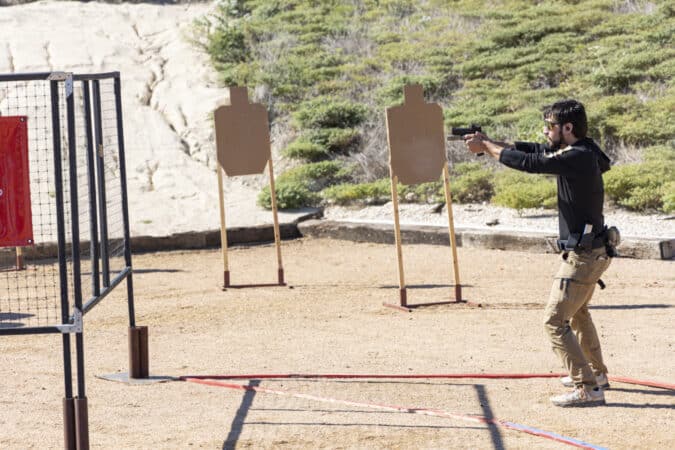
As we write this article, we’re awaiting a final production sample of the XC3, but our initial impressions during this event were positive. Aside from the prototype switch problem, which we’re told has been entirely resolved for the final production version, the XC3 was easy to use and produced plenty of light for fast target identification.
While it can’t compete with the long-range throw of SureFire’s X300 Turbo, we may be switching a few of our X300U-equipped guns over to the XC3 in the near future. The balance of versatile performance and IWB comfort seems hard to beat.
Read the full article here

